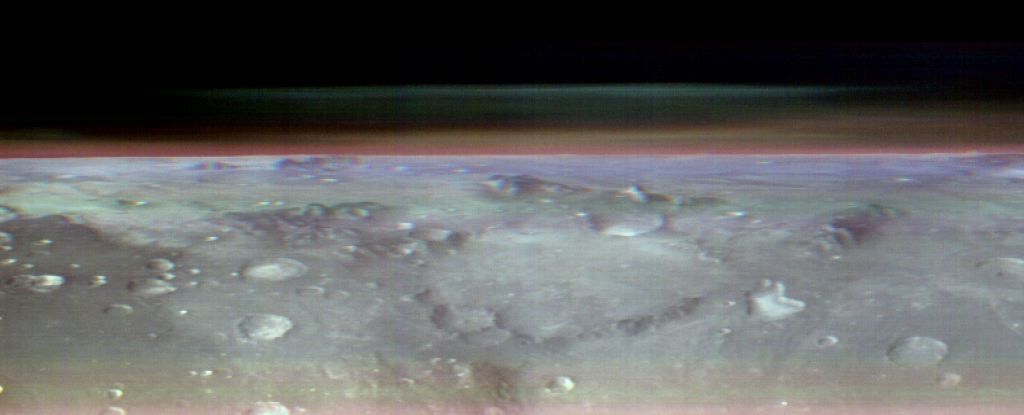NASA Reveals Breathtaking New Perspective of the Martian Horizon
Astronauts exploring the alien skies of the red planet may one day marvel at a vista akin to the one depicted above. This recently unveiled image captures the Mars horizon, courtesy of NASA’s Odyssey orbiter, as it gracefully traversed the planet at an altitude of approximately 400 kilometers (250 miles)—a height comparable to the average altitude of the International Space Station above Earth.

The successful capture of this image was an intricate undertaking that spanned several months. Scientists anticipate that this visual data will enable a comparative analysis of Mars and Earth, drawing parallels through similar photographs taken from the vantage point of the ISS.
Astronomer Jonathon Hill from Arizona State University notes, “If there were astronauts in orbit over Mars, this is the perspective they would have. No Mars spacecraft has ever had this kind of view before.”
The image, acquired using Odyssey’s Thermal Emission Imaging System (THEMIS), required meticulous coordination due to THEMIS’s fixed position on the orbiter, consistently pointing straight down at Mars from the spacecraft’s underside. While THEMIS is typically employed for mapping the Martian surface, this particular endeavor marked a departure from its routine usage.

To capture the Mars horizon, scientists on Earth orchestrated a series of commands that involved physically tilting the entire Odyssey orbiter by 90 degrees, aligning THEMIS with the rim of the horizon. Sustaining this orientation for an entire orbit was essential to afford THEMIS the necessary time to capture the sequence of 10 images that were later assembled into the panoramic view.
The process was tense, as the optimal positioning required the spacecraft’s antenna to be directed away from Earth throughout the project’s duration, rendering Odyssey temporarily inaccessible for communication with Earth.
Despite the nail-biting challenges, the outcome justified the meticulous effort. The resulting panorama unveils the arid, crater-dotted surface of Mars in the foreground—an intriguingly alien terrain. Above, the ethereal Martian atmosphere hovers delicately, adorned with wisps of clouds and suspended dust haze.

Given that THEMIS operates as a thermal camera, its data provides insights into the temperature of observed subjects, aiding in the study of clouds. Mars exhibits water ice clouds, akin to Earth’s captivating cloud formations. Additionally, the red planet features carbon dioxide ice clouds that materialize under specific atmospheric conditions, offering valuable information about the intricacies of the Martian atmosphere.
During its orientation toward the horizon, THEMIS inadvertently captured an additional element—a photobomber, in the form of Mars’ potato-shaped moon, Phobos.

Phobos completes an orbit around Mars in approximately 7.65 hours, yet its origins remain uncertain—whether it resulted from a passing asteroid captured by Mars’ gravitational pull or if it once constituted a fragment of the red planet itself. Each piece of information gathered about this diminutive moon serves as a valuable data point for scientists attempting to unravel this cosmic enigma.
With Odyssey showcasing its capabilities, researchers now aspire to capture additional images of the Martian horizon at various points throughout the year. This ongoing effort aims to observe how the Martian atmosphere evolves with changing seasons, offering the possibility of glimpsing the elusive green nightglow of Mars. Fingers crossed for further revelations.
This article is republished from ScienceAlert under a Creative Commons license. Read the original article.
Do not forget to share your opinion with us to provide you with the best posts !




0 Comments